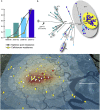Tracking the establishment of local endemic populations of an emergent enteric pathogen
- PMID: 24082120
- PMCID: PMC3808646
- DOI: 10.1073/pnas.1308632110
Tracking the establishment of local endemic populations of an emergent enteric pathogen
Abstract
Shigella sonnei is a human-adapted pathogen that is emerging globally as the dominant agent of bacterial dysentery. To investigate local establishment, we sequenced the genomes of 263 Vietnamese S. sonnei isolated over 15 y. Our data show that S. sonnei was introduced into Vietnam in the 1980s and has undergone localized clonal expansion, punctuated by genomic fixation events through periodic selective sweeps. We uncover geographical spread, spatially restricted frontier populations, and convergent evolution through local gene pool sampling. This work provides a unique, high-resolution insight into the microevolution of a pioneering human pathogen during its establishment in a new host population.
Keywords: drug resistance; enteric disease; genomics; phylogeography.
Conflict of interest statement
The authors declare no conflict of interest.
Figures



References
-
- Bangtrakulnonth A, et al. Shigella from humans in Thailand during 1993 to 2006: Spatial-time trends in species and serotype distribution. Foodborne Pathog Dis. 2008;5(6):773–784. - PubMed
Publication types
MeSH terms
Substances
Associated data
- Actions
- Actions
- Actions
Grants and funding
LinkOut - more resources
Full Text Sources
Other Literature Sources

